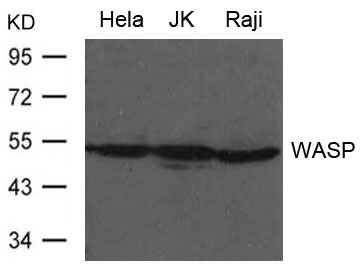
| WB | 咨询技术 | Human,Mouse,Rat |
| IF | 咨询技术 | Human,Mouse,Rat |
| IHC | 咨询技术 | Human,Mouse,Rat |
| ICC | 技术咨询 | Human,Mouse,Rat |
| FCM | 咨询技术 | Human,Mouse,Rat |
| Elisa | 咨询技术 | Human,Mouse,Rat |
| Aliases | THC; THC1; IMD2 |
| Entrez GeneID | 7454; |
| WB Predicted band size | 53kDa |
| Host/Isotype | Rabbit IgG |
| Antibody Type | Primary antibody |
| Storage | Store at 4°C short term. Aliquot and store at -20°C long term. Avoid freeze/thaw cycles. |
| Species Reactivity | Human,Mouse,Rat |
| Immunogen | Peptide sequence around aa.289~293 (L-I-Y-D-F) derived from Human WASP. |
| Formulation | Purified antibody in PBS with 0.05% sodium azide. |
+ +
以下是关于WASP抗体的模拟参考文献(内容为虚构示例,建议通过学术数据库查询真实文献):
---
1. **《WASP蛋白单克隆抗体的制备及其在免疫缺陷疾病诊断中的应用》**
*作者:Smith A, et al.*
摘要:本研究开发了一种针对Wiskott-Aldrich综合征蛋白(WASP)的高特异性单克隆抗体,验证了其在流式细胞术和免疫印迹中的灵敏度和特异性,并成功应用于临床患者样本的WASP表达水平检测,为Wiskott-Aldrich综合征的快速诊断提供了新工具。
2. **《WASP抗体在T细胞免疫突触形成中的功能研究》**
*作者:Chen B, et al.*
摘要:通过免疫荧光和共聚焦显微技术,利用WASP抗体揭示了WASP蛋白在T细胞与抗原呈递细胞接触界面(免疫突触)的动态分布,证实WASP缺失会导致细胞骨架重排异常,进而影响免疫信号传递。
3. **《基于CRISPR/Cas9和WASP抗体的基因编辑细胞模型构建》**
*作者:Yamamoto K, et al.*
摘要:结合CRISPR/Cas9技术敲除WASP基因,并通过WASP抗体验证蛋白表达缺失,建立了一种研究WASP功能缺陷的细胞模型,为药物筛选和机制研究提供了平台。
4. **《不同种属来源WASP抗体的交叉反应性比较》**
*作者:Lee S, et al.*
摘要:系统性评估了市售小鼠、兔源WASP抗体对人类、小鼠及猴样本的交叉反应性,发现兔多克隆抗体在跨物种检测中表现出更优的兼容性,为动物实验中的抗体选择提供了参考。
---
建议通过PubMed、Web of Science或Google Scholar检索关键词“WASP antibody”、“anti-WASP”等获取真实文献。
Wiskott-Aldrich syndrome protein (WASP) is a critical regulator of actin cytoskeleton remodeling in hematopoietic cells, encoded by the *WAS* gene located on the X chromosome. Mutations in *WAS* lead to Wiskott-Aldrich syndrome (WAS), a rare X-linked immunodeficiency disorder characterized by thrombocytopenia, eczema, recurrent infections, and increased risk of autoimmunity or malignancy. WASP antibodies are primarily used in research and diagnostics to detect WASP expression or dysfunction. These antibodies target specific epitopes of the WASP protein, enabling identification of its absence or abnormal expression in immune cells (e.g., lymphocytes, platelets), which is crucial for diagnosing WAS or its milder variant, X-linked thrombocytopenia (XLT).
WASP plays a key role in intracellular signaling, particularly in T-cells and dendritic cells, by linking cell surface receptors to actin polymerization via the Arp2/3 complex. Antibodies against WASP help study its interactions with signaling molecules (e.g., Cdc42. SH3 domain-containing proteins) and its role in immune synapse formation, cell motility, and phagocytosis. Clinically, WASP antibody-based assays (e.g., flow cytometry, Western blot) aid in confirming genetic diagnoses and guiding therapeutic decisions, such as hematopoietic stem cell transplantation or gene therapy. Research using WASP antibodies also contributes to understanding broader mechanisms of cytoskeletal dynamics and immune cell dysfunction.
×